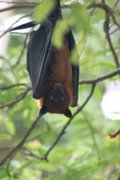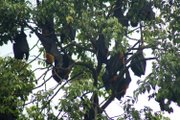“A cobra can strike twice the distance its head is raised while a king cobra three times,” the Director of the Wildlife Department pointed out to me.
What this means basically is that if the cobra raised its head two feet above the ground it can lunge a distance of four feet, while for a king cobra the distance would be six feet. But not to worry, after a cobra or king cobra had struck once and missed, they need some time to regain their energy before delivering the second strike. Their heads would be raised, hooded and all menacing, but basically harmless for 10 seconds at least. If you are Carl Lewis, you would be a hundred metres away by the time the snake is ready to deliver the second strike. If you could not quite match Mr Lewis in speed or need a calculator to work out the snake’s deadly range then the next best thing to do is add an extra five metres to whatever answer you derive from your calculations. A 10 metre head start does not guarantee you would automatically outrun the king cobra should it decide to seriously give chase. But at least nobody can accuse you of being an idiot for standing too close to the reptile. And please bear in mind also that an adult king cobra can raise itself to about five feet and look you straight in the eye. Not a comforting thought, eh?
This conversation I was having with the Director of Wildlife Department was during a snake show at a village call Ban Khok Sa-nga in Khon Kaen Province, Northeast Thailand. I was acting as chaperone to a group of snake handlers from the Perlis Snake Farm who had been invited to perform at the said village, located 49km out of Khon Kaen town. Villagers in Ban Khok Sa-nga seemed to have very little fear of king cobras, which are kept as pets in most households.
Meanwhile up on stage a Thai snake handler was having a “boxing match” with a king cobra, slapping the snake’s cheek and darting out of the way every time it struck accompanied by a roar from the crowd. He was the village champion, a man just in his early 20s. Frustrated and certainly irritated, the snake at last gave up, unhooded its head and glided away looking for a dark corner to hide. That is what most snakes like doing, slither into a dark damp corner. Not very different from a few reptiles posing as mammals that I have encountered.
That particular snake secure at last in a box, out came a bigger one. A different snake handler this time pitted his agility against the new opponent. Again man proved to be too fast for the snake although he did not exactly stay the required distance my friend from the Wildlife Department had told me was the safe distance. But then they are all professionals and I on the other hand have this irrational fear of snakes, especially the venomous ones. Came from encountering cobras too many times as a child growing up on the outskirts of Kota Bharu in the 1960s. One day while home alone I also saw a pair of cobras slither under the house. We live in a house on stilts in those days. A cobra also killed one of my mother’s cat. It was soon put to rest, the snake that is, by a group of neighbours armed with bamboo stakes. In a terribly Hollywod or Bollywood manner, the cat actually waited for my mother to come home from work before taking its final breath.
According to those in the know, you can only kill a cobra with bamboo stakes though I reckon a baseball bat or golf club would also do the job if one is at hand. Only thing is that with a bamboo stake you can stand 10 feet away and have a go at it, while with a golf club or baseball bat you would have to get up very close and personal to do the job. Shy a creature as it may be a cobra cornered is definitely going to be in no mood to let you have a go at it without puuting up some sort of defence. And if you do not have the agility of a mongoose then you may end up ith a few love bites on your ankles. I was told that for some reason or other to keep snakes out of your compound sprinkle sulphur around your house. But personally I have found that kafir lime seemed to work better because sulphur tends to get washed away very quickly when it rains.
It was also pointed out to me that it is wrong to say that snakes or cobras in particular are poisonous. It is not, which explains why some people find their meat a delicacy. Others say drinking cobra’s blood is also supposed to cleanse your own blood. This accounted for the number of shops willing to slaughter cobras just so that you can clean your bad blood. Silly me, since all this while I thought drinking eight pints of plain water is good enough to get your kidneys to do the job of cleansing your blood. It seemed that some people had discovered a easier although somewhat less humane way to do the job. Personally I find going to the fridge for water a lot less distressing than going to the forests and trying to bag a cobra.
All snakes, however, are venomous, especially the ones whose heads are more or less triangular in shape. A baby king cobra, just hatched, already come equipped with enough venom to kill an animal a few times its size. A drop of venom from a king cobra or cobra is enough to kill 40 human adults or a horse. That should give you a good idea of how potent and dangerous their bite could be. Regardless of whether it is a fully grown adult or just a cute little baby. Certainly a case of the bite being more lethal than the bark. Strangely enough, the Thai name for a cobra is ngu hao (translated as barking snake). I did not find out whether cobras do indeed bark. I did not hear any barking from 10 feet away and have no desire to get any closer or give it a tight slap just to see if it emulate a dog. As a word of caution, no matter how much you desire to do so (especially the women out there) kindly refrain from giving a baby king cobra a cuddle even if your maternal instincts were deeply aroused.
Now we come to the who wants to be a millionaire questions:
After being bitten by a cobra or king cobra, how much time would you have left? The answer is cobra – 40 minutes, king cobra – 20 minutes (more or less). Next question, is it safe to suck the venom out with your mouth? Just in case you have no suction pump at hand. In theory, yes, provided you do not have a cavity. If not, the venom is now entering your blood stream through two channels. Good luck. Third question, why are the venom glands (located just behind its eyes) not removed for cobras used in shows? Removing the glands would kill the snake because it needs the venom to kill its prey and digest the food. Fourth question, why is it called a king cobra? Because it eats other snakes (including common cobras).
And the most important question of all, why the headline above? Well, our local Khon Kaen hero, the village champion had his last show a few weeks after I saw him performing. He made two mistakes that fateful day. First was not getting out of the way fast enough. The snake’s fangs went through his jeans and puncture the skin in his knee. Second mistake was thinking that since he had been bitten before he would have more resistance to the venom, so he continued with the show instead of seeking immediate medical treatment. It proved to be a fatal miscalculation on his part.
Thursday, June 07, 2007
Subscribe to:
Post Comments (Atom)



















No comments:
Post a Comment